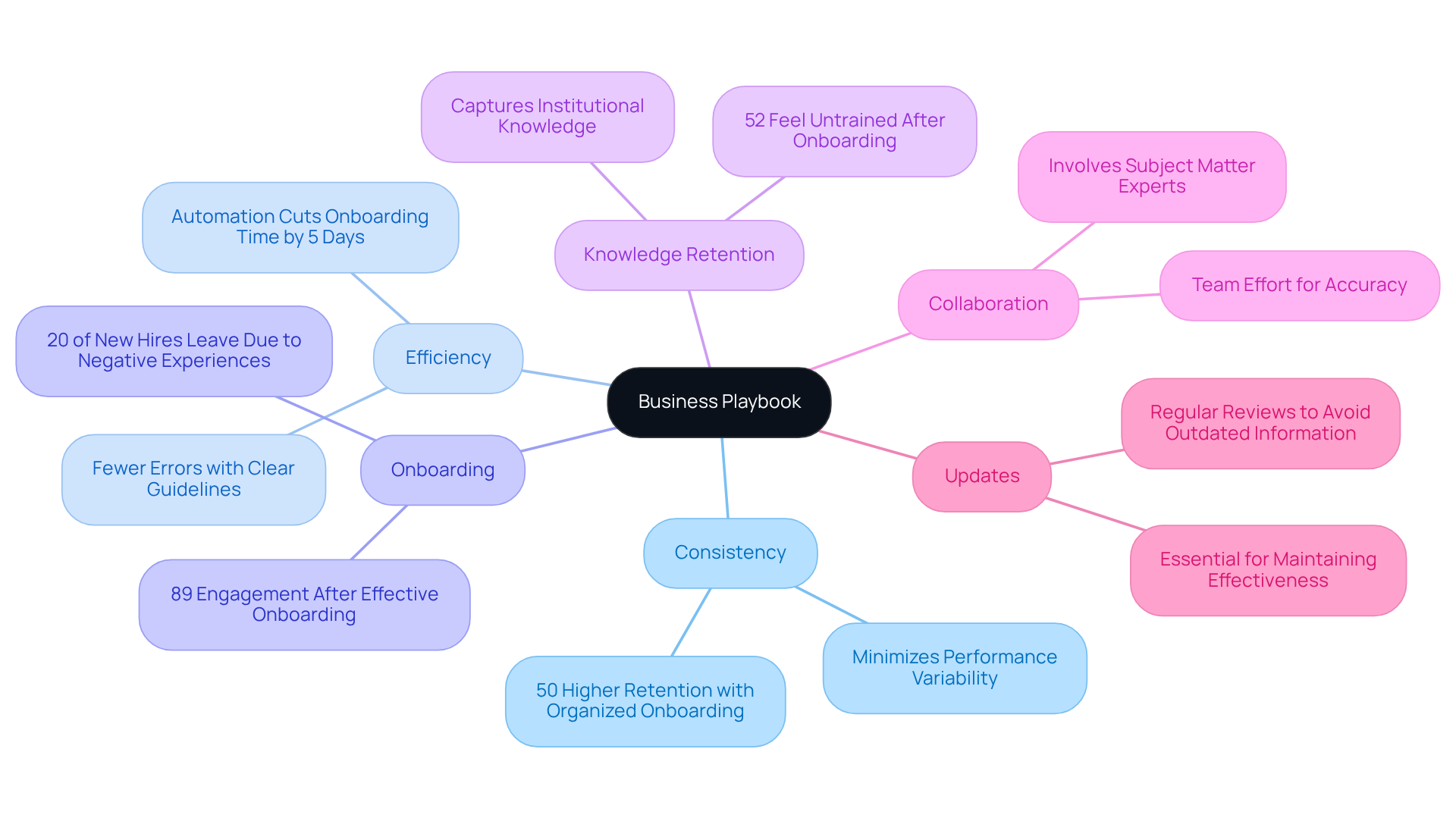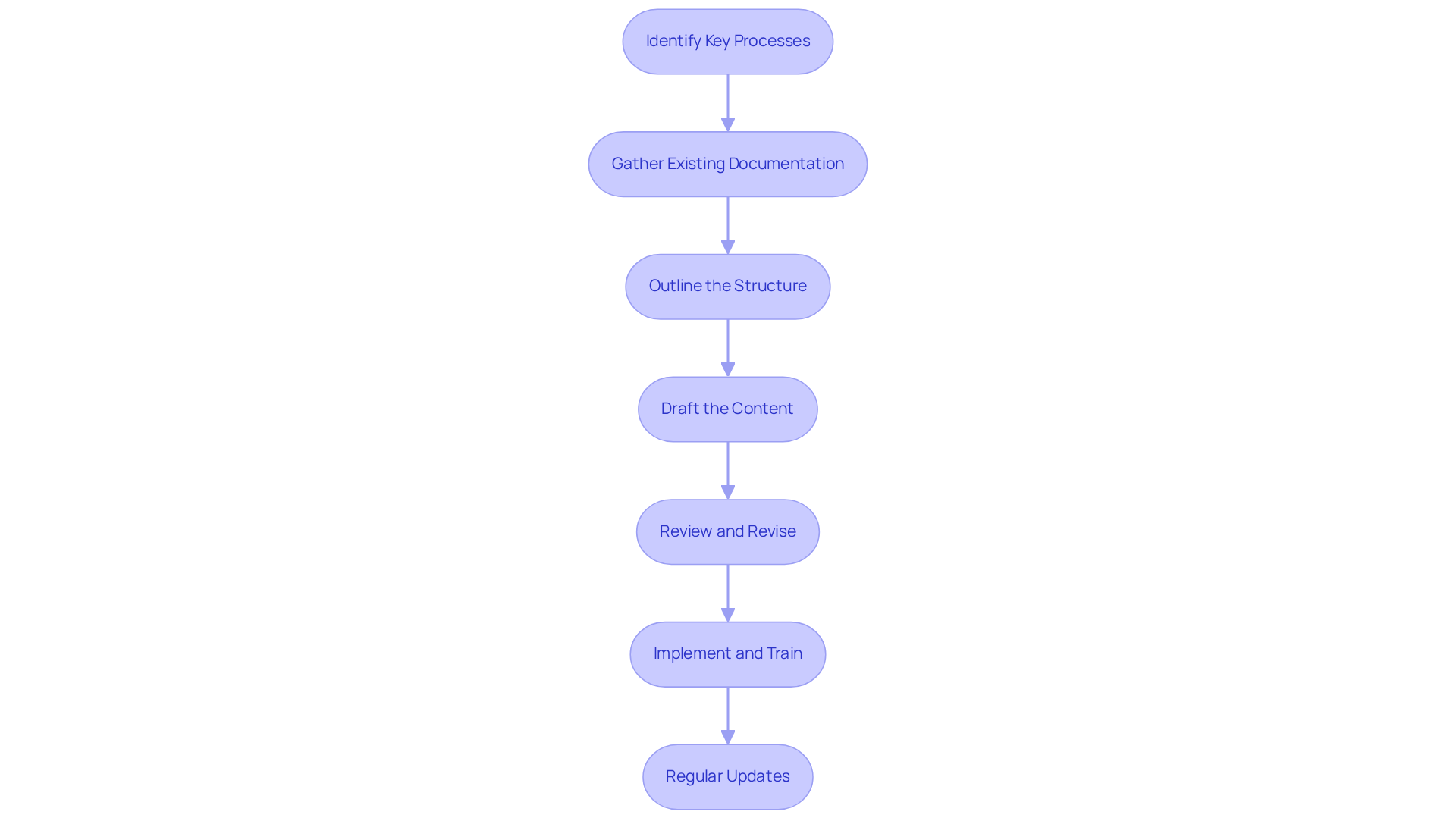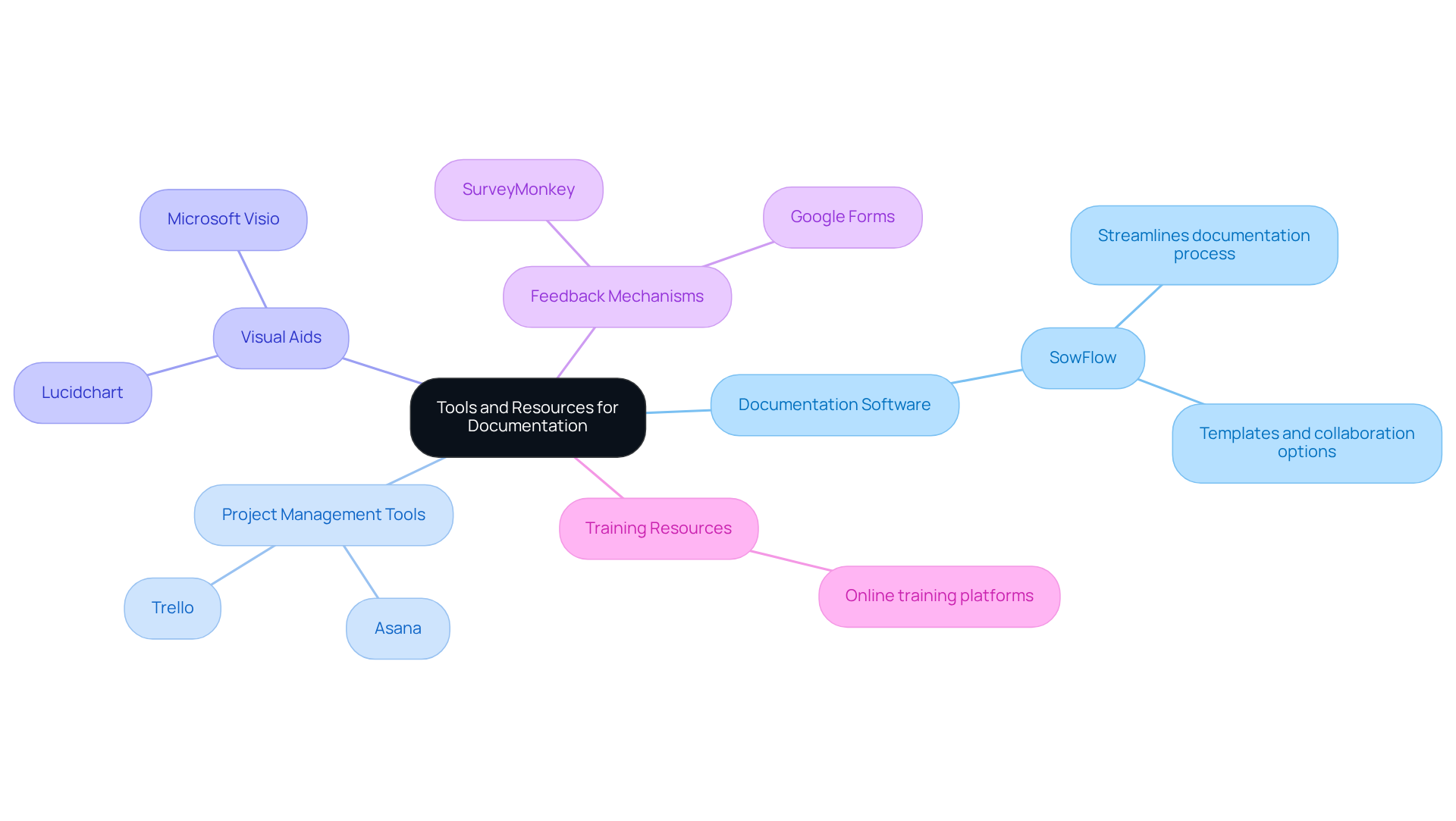
Knowledge Management through Documentation
|
October 16, 2025
|
Create a Playbook: A Step-by-Step Guide for Operations Managers
Overview
You might be wondering how to create an effective business playbook. Well, this article serves as a comprehensive guide for operations managers, highlighting the playbook's importance in standardizing procedures, boosting efficiency, and enhancing employee retention.
By laying out a step-by-step process—like:
- Identifying key processes
- Gathering existing documentation
- Regularly updating the playbook
it shows how these practices can lead to better onboarding experiences and improved knowledge retention.
Ultimately, this all adds up to a significant boost in overall organizational productivity. So, let’s dive into how you can make this work for you!
Key Highlights:
- A business playbook outlines standard operating procedures, workflows, and best practises, serving as a reference for employees.
- Consistency in procedures minimises performance variability and increases employee retention rates.
- Clear guidelines enhance efficiency, allowing employees to complete tasks more swiftly and accurately.
- Effective onboarding processes can significantly reduce turnover, with 20% of new hires leaving within 45 days due to poor experiences.
- Knowledge retention is crucial, as a playbook captures institutional knowledge, aiding transitions when employees leave or change roles.
- Collaboration in creating the playbook involves input from various subject matter experts to ensure accuracy.
- Regular updates to the playbook are essential for maintaining its relevance as the organisation evolves.
- Steps for creating a playbook include identifying key processes, gathering existing documentation, outlining structure, drafting content, reviewing, implementing training, and scheduling updates.
- Tools like SowFlow streamline documentation; project management tools help organise development; visual aids clarify workflows; feedback mechanisms ensure usability; and training resources enhance skills.
Introduction
Creating a business playbook isn’t just a task; it’s a fantastic opportunity for operations managers like you to streamline processes and boost team performance. Think of it as your go-to guide—a comprehensive reference that ensures consistency, efficiency, and knowledge retention across your organization.
But here’s the catch: capturing the unique nuances of each operation while keeping pace with our ever-changing business landscape can be tricky.
So, what steps can you take to craft a playbook that not only meets your immediate needs but also evolves alongside your organization?
Define the Business Playbook and Its Importance
You might be wondering just how important an organizational guide really is. Well, it’s a vital document used to create a playbook that outlines standard operating procedures (SOPs), workflows, and best practices within a company. Think of it as a thorough reference manual for employees, ensuring everyone is on the same page with the company’s goals and procedures. The significance of creating a playbook for business operations is profound!
First off, let’s talk about consistency. It guarantees that all team members stick to the same procedures, which really helps minimize performance variability. This is crucial because organizations with organized onboarding systems are 50% more likely to keep new hires compared to those that don’t have them. Plus, businesses with a smooth onboarding process can boost their employee retention rates by 52%—now that’s impressive!
Next up is efficiency. When employees have clear guidelines, they can get tasks done more swiftly and accurately, which means fewer errors. For example, companies that implement effective onboarding strategies can save a ton of time and resources, with automation potentially cutting onboarding time by five days. And guess what? Retention rates improve by 16% when certain onboarding tasks are automated.
Now, let’s dive into onboarding. New hires can get acclimated more quickly by using the guide, which streamlines training and cuts down on orientation time. Did you know that 20% of new hires leave within the first 45 days due to negative onboarding experiences? And 9% quit because of a poor onboarding experience? That really highlights the need for effective resources. When done right, onboarding can help create a playbook that boosts performance, job satisfaction, and retention.
Another key aspect is knowledge retention. This document captures institutional knowledge, making transitions smoother when employees leave or shift roles. This is especially important since 52% of new hires feel untrained after their onboarding experience, which underscores the necessity of comprehensive documentation.
Let’s not forget about collaboration. To create a playbook, developing a company guide should be a team effort, involving various subject matter experts to ensure precision and significance.
And finally, updates are crucial. It’s essential to keep the strategy document revised as the organization grows and evolves to maintain its effectiveness.
In conclusion, a well-organized operational guide is essential for success. It offers a structured way to manage tasks and greatly improves overall productivity. So, what do you think? Ready to dive into creating or updating your own organizational guide?

Step-by-Step Process for Creating Your Playbook
To really boost your operational efficiency, you should create a playbook for your business! So, where do you start? Here are some essential steps to guide you:
- Identify Key Processes. You might be wondering, what are the core processes that are vital to my operations? Collaborate with your team to gather insights on what should be included. It’s important to ensure that every perspective is considered.
- Next, let’s Gather Existing Documentation. Compile any standard operating procedures (SOPs), guidelines, or resources you already have. This not only saves you time but also promotes uniformity throughout your records. With SowFlow, keeping your documentation relevant is a breeze, even in today’s fast-paced business environment.
- Now, it’s time to Outline the Structure. Think about how to create a playbook format. Typical sections include an introduction, detailed descriptions of procedures, roles and responsibilities, and troubleshooting tips. These components will help everyone navigate the content efficiently.
- When you’re ready, go ahead and Draft the Content. Start writing each section using clear and concise language. Don’t forget to include step-by-step instructions for each process! Visual aids like flowcharts or diagrams can really enhance understanding and retention. Plus, SowFlow's user guide creation tools make it easy to create these guides, ensuring your materials are comprehensive and accessible.
- Once you have a draft, it’s time to Review and Revise. Share it with key stakeholders for their feedback. Revising based on their input is crucial for accuracy and clarity, which are essential for effective implementation. With SowFlow's immediate record-keeping features, you can quickly integrate feedback and keep your strategy up to date.
- After finalizing the guide, it’s time to Implement and Train. Distribute it to your team and conduct training sessions to get everyone familiar with the content. This is where SowFlow's solutions come in handy, simplifying the training process and ensuring that all team members can access the documentation they need without unnecessary meetings.
- Don’t forget about Regular Updates! Establish a schedule for reviewing and updating the guide to keep it relevant as processes evolve. Regular updates ensure that the guide remains a valuable resource, helping to minimize errors and enhance decision-making. In fact, did you know that 40% of organizations reported fewer mistakes after adopting organized record-keeping methods? That really highlights the importance of efficient guides. Plus, companies lose around $1.3 million each year due to ineffective methods, emphasizing the need for thorough records that can be easily managed with SowFlow.
By following these steps and utilizing SowFlow's innovative documentation solutions, you can create a comprehensive guide that serves as a centralized collection of procedures and policies. This not only empowers your employees to take ownership of their roles but also fosters a culture of continuous improvement. As Johnny Page wisely noted, "A company manual is a document that includes all of an organization’s procedures, policies, and standard operating procedures (SOPs)." Including communication policies and addressing frequently asked questions in your guide can further strengthen team alignment and effectiveness.

Utilize Tools and Resources for Effective Documentation
To create a playbook for an effective business, you might be wondering what tools and resources can help you out. Here are some great options to consider:
- Documentation Software: Have you heard of SowFlow? This tool streamlines the documentation process, making it super easy to create, edit, and manage your playbook. As Anastasia Masadi, a Product Owner, puts it, "SowFlow has transformed how we document work and deliver to our clients. I can create SOPs and training materials without leaving the browser or taking separate screenshots, saving me valuable time." Look for features like templates, collaboration options, and version control to boost your productivity. Did you know that organizations can cut down up to 75% of the time spent on Sales Management and Human Resources by using efficient record-keeping methods?
- Project Management Tools: Platforms like Trello and Asana are lifesavers for organizing your playbook development. They let you assign tasks, track progress, and collaborate better with your team, leading to a more structured approach to documentation.
- Visual Aids: Now, let’s dive into visual aids! Tools like Lucidchart or Microsoft Visio can help you create flowcharts and workflow maps. These visuals clarify workflows, making it easier for everyone to grasp those complex processes.
- Feedback Mechanisms: It’s always a good idea to gather feedback, right? Implement tools like Google Forms or SurveyMonkey to get insights from your team about the document's content and usability. Consistent feedback ensures that your guide stays relevant and user-friendly, adapting to your organization’s needs.
- Training Resources: Investing in online training platforms can really level up your team's skills in creating and maintaining effective guides. These courses on best practices for written materials promote a culture of ongoing improvement and ensure that your record-keeping practices evolve alongside your organization.
By leveraging these tools and resources, you can simplify the documentation process to create a playbook that is comprehensive, accessible, and easy to update. This structured approach not only boosts efficiency but also enhances knowledge management within your organization.

Conclusion
Creating a business playbook isn’t just a task; it’s a smart move toward operational excellence. You might be wondering how a comprehensive guide that outlines standard operating procedures, workflows, and best practices can really make a difference. Well, by doing this, organizations can ensure consistency, efficiency, and better collaboration among team members. This structured approach not only makes onboarding smoother but also captures vital institutional knowledge, turning it into a priceless resource for current and future employees.
Throughout this article, we’ve highlighted why consistency in operations matters, how clear guidelines boost efficiency, and the key role effective onboarding plays in keeping employees around. Plus, don’t forget the importance of regularly updating that playbook and collaborating with your team to keep it relevant as your organization grows. Tools like documentation software and project management platforms can really streamline the process of creating and maintaining a playbook, leading to improved productivity and fewer errors.
In today’s fast-paced business world, having a well-organized operational guide is more important than ever. So, why not take the plunge? Invest the time and resources to develop or refine your business playbook. By doing so, you’ll not only empower your employees but also nurture a culture of continuous improvement that can pave the way for long-term success. Embrace the chance to create a playbook that aligns with your organizational goals and boosts operational efficiency!
Frequently Asked Questions
What is a business playbook?
A business playbook is an organizational guide that outlines standard operating procedures (SOPs), workflows, and best practices within a company, serving as a reference manual for employees.
Why is a business playbook important?
A business playbook is important because it ensures consistency among team members, improves efficiency, enhances onboarding processes, aids in knowledge retention, fosters collaboration, and requires regular updates to remain effective.
How does a playbook contribute to consistency in an organization?
A playbook guarantees that all team members adhere to the same procedures, which minimizes performance variability and helps maintain uniformity in operations.
What impact does effective onboarding have on employee retention?
Organizations with organized onboarding systems are 50% more likely to retain new hires, and implementing smooth onboarding processes can boost retention rates by 52%.
How does a business playbook enhance efficiency?
With clear guidelines provided by the playbook, employees can complete tasks more quickly and accurately, leading to fewer errors and saving time and resources during onboarding.
What are the consequences of negative onboarding experiences?
About 20% of new hires leave within the first 45 days due to negative onboarding experiences, and 9% quit because of poor onboarding, highlighting the importance of effective onboarding resources.
How does a playbook aid in knowledge retention?
A playbook captures institutional knowledge, making transitions smoother when employees leave or change roles, which is crucial since 52% of new hires feel untrained after their onboarding experience.
Why is collaboration important in creating a business playbook?
Developing a business playbook should be a team effort involving various subject matter experts to ensure the accuracy and relevance of the content.
Why are updates necessary for a business playbook?
Regular updates are essential to keep the strategy document relevant and effective as the organization grows and evolves.
👍
What others are liking
5 Steps to outline your ideal documentation structure
5 MINS READ
Where to start the your journey of mapping out your ideal documentation structure, aligning it with the very heartbeat of your organization?
Defining a winning level of detail in your process
3 MINS READ
What is too much detail, and what is too little? This article described in that winning level detail about what detail is enough.





